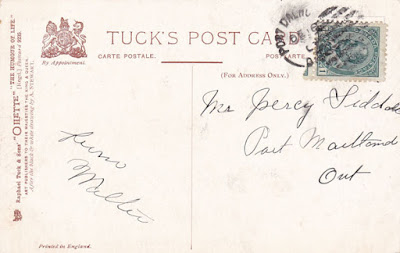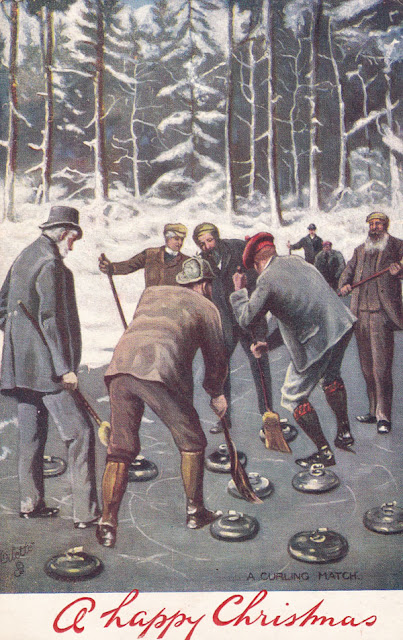The pond at Carsebreck had seen 23 Grand Matches since it was first used in 1853. Only one match had been held on the pond since the end of the Great War.
The draw for the 1927-28 Grand Match was published in early November, 1927, the Scotsman, for example, printing the full list of games.
The Dundee Courier, of November 18, 1927, also printed the full draw. There were to be 244 rinks in the North v South match, and 56 rinks for the President v President-elect match. Note that the use of 'rinks' here refers to the number of matchups, and so the number of individual teams expected to appear was 488 for the main match and 112 for the other, ie 600 in total = 2400 curlers.
Local newspapers, such as the Kirkintilloch Gazette of November 25, 1927, noted that the Grand Match was planned for Carsebreck 'if ice permits', and printed just those games which would involve local curling clubs.
By the end of December, excitement was beginning to build that the Grand Match would take place. The Dundee Courier (above) and the Scotsman on December 30 reported that the ice at Carsebreck was nearly four inches thick, with a covering of snow. As it was still freezing, the date of January 4, 1928, was provisionally fixed for the Grand Match.
On January 2 of the new year, the Dundee Courier ran a large article which contains lots of interesting detail for the Grand Match enthusiast today. For example, "Two months ago or more the Railway Companies drew up timetables for long-distance trains to transport the curlers to and from Carsebreck, and so carefully were the advance arrangements made that the whole transport scheme is put into operation at a few hours notice."
Transport to the Carsebreck loch by train had been a key component of the Grand Match since the first match held there in 1853. There was even a special halt on the nearby railway line, see here.
"Every morning for days past, Mr Wm Angus, of Carsebreck Farm, has measured the thickness of the ice on the loch and kept the Royal Club secretary in Edinburgh informed of the daily prospects for the Grand match. At least four inches of ice are required, and the thickness was fully that yesterday, with a slight covering of snow over the expansive surface."
We learn too that David King, foreman platelayer of Stirling Road, Blackford, was the man in charge of preparations at the pond and had a squad of 32 men to mark out the 300 rinks.
The Dundee Courier article noted that the whole area of the loch (60 acres) would be used for the bonspiel. The reporter had calculated that the ice would have to bear some 255 tons, and the marking out of the rinks was carried out 'to ensure an even distribution of weight over the 60 odd acres of ice'.
The article continues, "Small wonder then that the responsible officials make doubly sure of the soundness and thickness of the Carsebreck ice before summoning Scottish curlers to the Grand Match. True, there is a belief that curlers won't drown, but the Royal Caledonian Club take no risks."
On the morning of Monday, January 3, there was 'a fine layer of ice on the loch' and Andrew Hamilton, the Secretary of the Royal Caledonian Curling Club, declared 'Match ON', with play set to begin at 11.30 the following day.
Monday's Dundee Evening Telegraph reported that curlers from Nairn and Kingussie were already en route that afternoon, spending the night in Aberdeen or Perth in order to catch the trains to Carsebreck the next morning. Representatives from Coldstream, Kelso, Jedburgh, Selkirk and Earlston were also on their way from the south, to overnight in Edinburgh.
By all accounts, transport arrangements to Carsebreck worked well. But, unfortunately, the weather did not play ball.
This photo from the following day's Dundee Evening Telegraph shows the problem. On the morning of January 4, it had begun to rain. Those arriving early found that rain had been falling since early morning. It appeared to dry up at one point, and a rainbow appeared. But then the rain began again, in earnest.
The Grand Match was scheduled to begin at 11.30, instead of at mid-day, as in former years. At 11.20 the announcement that the match would not take place was made by megaphone, and to signal this shots were fired. This photo shows the guns being fired to indicate that the match had been called off.
When the Royal Club Annual was published later in the year, the report of the Grand Match began, "The day of the abortive Grand Match of 1928 will long be remembered as a black day in the Annals of Curling, when Jack Frost played an army of curlers a nasty trick by tempting them out in their thousands and then levanting at the last moment, and leaving them soaked and disappointed to take their various homeward ways."
The Annual also reprinted the photo above which shows a number of curlers on the loch, waiting to learn if the match would go ahead. This photo had originally appeared in the Illustrated Sporting and Dramatic News on Saturday, January 14, 1928, with the legend, 'Bonspiel abandoned: The curlers on the pond at Carsebreck'.
The bonspiel, unfortunately, could not be cancelled earlier. Conditions seemed all that could be desired last night and early this morning. A sheet of ice five inches thick covered the spacious loch, and, although a dampness lay on the ice, there was no water until the rain began about six o'clock. The markings of the rinks up till then were quite distinct. A fresh wind which began to blow at ten o'clock last night proved the forerunner of this morning's rain, which showed no signs of abating when the time for play drew near. With a sheet of water, inches deep in parts, covering the rinks, it was decided, ten minutes before the bonspiel was due to start, that play would be impossible. A deluge of rain was falling at the time, the rink markings had long since been obliterated, and there was also the prospect of the loch becoming dangerous for curlers."
The Editorial in the Annual for 1928-29 reflected, "The disappointment to the Secretary and his staff of assistants after all their multifarious work in organising and preparing for the Grand Match, and the chagrin occasioned to the huge concourse of curlers that assembled on the margin of the club's pond, was like a huge practical joke perpetrated by natural forces against the curling fraternity, and shows that curling is, in more senses than one, 'a slippery game'. The contretemps brought out the sport's manlike spirit of the curling army that had mustered 'boden in fier of war' (equipped for war) beside the battlefield, only 'to find nae field to fecht in' (no field to fight in); and those who had often proved that they knew how to play the game, showed that they furthermore knew how, on occasion, not to play it."
A correspondent simply describing himself 'Anthony' contributed the following to the Edinburgh Evening News of January 5, 1928. "The scene was a strange one. The great loch stretched into a faint haar, and the trees on the banks of a hill on the horizon were likewise mist-kissed, having a quaint, ghostly appearance. Hills on all sides lost themselves in their burdens of mist - grey, clinging, soaking mist which matched and met the sky low down.
The rain was the kind of rain that doesn't dance off your mackintosh, but creeps down your neck and burrows up your sleeve. It came from all directions. You stood on the rain, you walked about with the rain, you breathed in the rain.
The curlers were attired in all sorts of rig-out. Some were in kilts. A large number wore Balmoral bonnets. Amongst the whole two thousand present, only one was noticed with an umbrella."
A few adventurous curlers threw some stones, despite the conditions. The Dundee Courier reported, "Stones were tried on the ice, but miniature geysers sprang from them as they went their way."
This photo shows many of the disappointed curlers headed back to the railway platform. The pond is in the distance, and the Royal Club Secretary's hut, the only building on site, can be seen top right.
This photo in the Dundee Evening Telegraph is captioned, "Lord Kinnaird of Rossie Priory and his factor, Mr Macdonald, taking their curling equipment to the station by sledge." One has to imagine that it must have become rather muddy! How stones were transported has been discussed before, see here, and the photo shows that Lord Kinnaid and his factor had two stones in separate boxes, and two in baskets.
For the departing curlers it had been arranged that nine special trains would take curlers away from Carsebreck after the bonspiel. The first of these had been due to leave at 14.55, after the curling was over. However, with the cancellation of the match, the timings were all brought forward, and very quickly all curlers were on their way home!
To make sure that everyone caught the correct train, several enclosures had been erected alongside the platform, to separate the passengers for the different trains, and to avoid overcrowding and crushing.
This photo from the Annual of 1928-29 carries no explanation. The Sunday Post, a few days later on January 8, printed a similar scene, explaining, "The curlers took the news of the abandonment of the bonspiel very philosophically. The contents of their knapsacks were immediately ransacked, and it was not their oversocks that they passed around to their friends."
The Scotsman similarly reported how the players reacted to the cancellation of the match, "Keen though their disappointment must have been, they received the decision philosophically, in the true curling spirit. Curlers are, of course, used to the caprices of the weather, and the decision was not unexpected; yet at the same time it was satisfactory to note the spirit in which it was taken and to hear such remarks as 'Better luck next time'.
The 'beef and greens' part of the curlers' traditional dish was lacking, but the liquid with which that repast ought to be washed down, according to the unwritten laws of curling, was not, and that, no doubt, offered some consolation for the unhappy day."
Not all of the competitors travelled to Carsebreck by train. By 1928, other transport options were available. One player travelled to the venue by car, and later complained that because of a lack of signs, he took the wrong road and had to carry his stones more than a mile to the pond side!
Those who travelled by bus had an exciting journey, according to the above account.
The final irony on that day in January 1928 was that, in the afternoon after everyone had left, a group of curlers from the Kincardine Castle CC, whose secretary lived in nearby Auchterarder, returned to the pond and played for three hours. According to the Dundee Courier, "The ice was in fairly good condition, and keen stones were thrown, while the ice was otherwise deserted." The paper recorded the names of the players. James Fleming and James Eadie were the skips, and the other players were E Forrester, James Reid, T Callum, John McNee, H Elliot and James Dow.
The following season saw the staging of a successful Grand Match at Carsebreck. Read the story of that match on the Royal Club website here.
Newspaper clippings and photographs are © as indicated, courtesy of the British Newspaper Archive. The other two photos are from the Royal Caledonian Curling Club Annual for 1928-29.




































